We’re fortunate to find artichoke country just down the road. You’ve probably passed the fields along the highway near Castroville, on the way to Monterey Bay. They’re covered in row upon row of sprawling plants with grayish-green, sawtooth leaves arching like gangly monster legs. The artichokes we eat are flower buds, and you’ll spy them—perched on the end of long stems, like leafy torches. Unharvested buds eventually produce majestic, purple flowers in summertime—the biggest thistles around.
California produces virtually all of the artichokes grown in the United States, and most of them, in Monterey County. As far as artichoke-producing countries go though, we’re not highly conversant with this spiky vegetable. In fact, many, if not most, Americans have never eaten a fresh one. In other parts of the world—particularly the Mediterranean region—artichokes are everyday food, and as loved as any vegetable could be. Their popularity has a long history, dating back to ancient times. Paired with olive oil, lemon, garlic, perhaps a glug of wine and a few olives—North Africans and Southern Europeans love their artichokes. And with good reason since their antioxidant content has significant health potential—supporting liver function and healthy digestion, as well as reducing cholesterol and hypertension. Artichokes are also a rich source of dietary fiber, with beneficial amounts of Vitamins K and C, folate and potassium.
Try one simply steamed. Or trim it down to the tender heart and bottom to stuff, poach, roast or sauté in any number of preparations—a salad, soup, side-dish or appetizer. The trimming process involves a few steps, something you might not be up for on a workday. But it’s not complicated or time-consuming, and leads to delicious possibilities beyond the ordinary. So try it sometime.
Here’s how to trim an artichoke down to its bottom. First remove the stem and pull off the outer leaves. Watch out for thorns at the tips. If you find them particularly menacing, use a pair of scissors to cut from each leaf. Or simply tough it out, being extra careful not to pierce a finger.
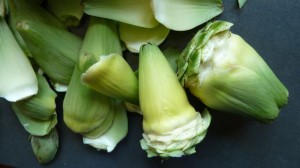 Peel all the way down to the light greenish-yellow leaves. As you go, save the meatiest leaves, which you can steam in a pot of simmering water for 15 minutes or until tender. Enjoy with melted butter, aioli or vinaigrette as an appetizer.
Peel all the way down to the light greenish-yellow leaves. As you go, save the meatiest leaves, which you can steam in a pot of simmering water for 15 minutes or until tender. Enjoy with melted butter, aioli or vinaigrette as an appetizer.
Once you’re down to the purple-tipped wisps at the inner core, you’re ready to remove the fibrous choke that lies below, on top of the artichoke bottom. Using a sharp knife, cut into the bottom at an angle, following the circumference of the leaves.
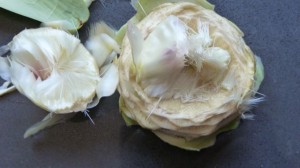 Pry the disc out with the knife. Scrape any remaining choke off with a spoon, and discard. Trim the underside of the artichoke bottom to remove any leaf remnants and tough outer skin around the stem.
Pry the disc out with the knife. Scrape any remaining choke off with a spoon, and discard. Trim the underside of the artichoke bottom to remove any leaf remnants and tough outer skin around the stem.
Squeeze lemon juice on the prepared bottom, and place into a bowl of ice water mixed with fresh lemon juice. The acidic juice prevents the artichoke from discoloring like a cut potato. Your artichoke bottom is now ready for cooking as you like.
To trim an artichoke down to its heart (the bottom plus the tenderest interior leaves) remove the leaves down to the pale, inner layer of leaves (second picture in the sequence above). Cut the top off the artichoke with a sharp knife, and trim off remnants of the leaves attached to the base, plus the outer layer of the stem. Cut in half lengthwise, from the top through the stem. Using a spoon, dig out the hairy, fibrous choke and core of prickly, purplish leaves. You’ll be left with the heart as pictured on the left in the image immediately above. Squeeze lemon juice over the halves and place in a bowl of ice water with fresh lemon juice to prevent discoloration.
Recipes for the Week:
 Roasted Red Pepper Soup with Artichokes and Tomatoes
Roasted Red Pepper Soup with Artichokes and Tomatoes
Try this simple soup with canned tomatoes and bottled peppers, or use the harvest of the summer season when it becomes available. Either way the results are deeply satisfying.
Braised Artichokes with Olives and Garlic
This surprisingly easy appetizer will garner rave reviews—it’s loaded with garlic and a hint of lemon. Soak up the juices with the crusty end of an Italian loaf. Heaven.
 Vegetarian Kale and Lettuce Caesar Salad
Vegetarian Kale and Lettuce Caesar Salad
Kale holds up perfectly to flavorful, creamy Caesar dressing. This one’s an eggless, anchovy-free version that’s packed with a lemony punch.
Try one of these ideas with your ruby-hued rhubarb stalks: rhubarb bars, ice cream, syrup or fruity compote. Plus stay tuned for a comforting crumble, on its way just in time for the weekend. Subscribe via email (on our home journal page), and you’ll receive a recipe post later this week (and all future posts as well) with all the yummy details.
Quick Tips:
For fava bean prep, check out the instructions in a previous week’s journal post. Sauté the shelled beans with plenty of minced garlic and olive oil. Mash into a loose paste with fresh lemon juice and spread on warm pita bread or scoop with a crisp carrot.
Slice a ripe avocado into a lettuce salad with quartered apricots. Dress with balsamic vinaigrette and toss in toasted almonds or walnuts.
Mix goat cheese and cream cheese, in equal proportions. Spread on toast and top with slices of apricot. Mash the fruit and cheese together a bit and drizzle with honey. Add a few toasted walnuts. Or top with some rhubarb compote if you’ve dared to mix one up.
It’s not quite basil season yet, so mix up a cilantro pesto while you’re waiting. You’ll find it vibrant in color and flavor. Process one bunch, rinsed, chopped cilantro (soft stems and leaves); 3 cloves minced garlic; 1/4 cup walnuts; and 1/4 cup olive oil, in a food processor, fitted with the metal cutting blade, until smooth. Add more oil as needed to achieve a smooth consistency. Add salt and lemon juice to taste. Store in the fridge. Spread in a sandwich, toss with pasta, drizzle over tomatoes or roasted spring veggies, add to salad dressing.

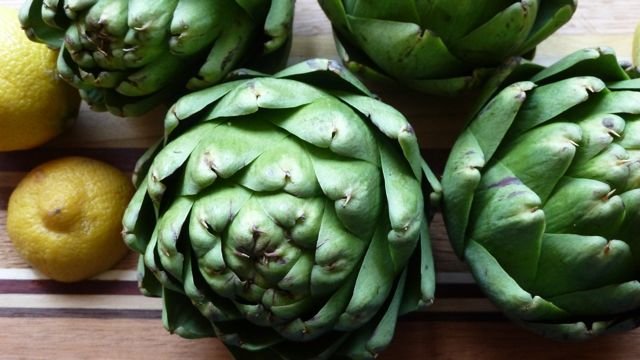
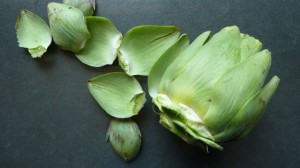
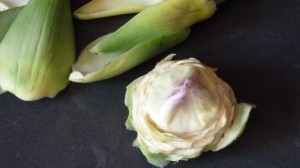

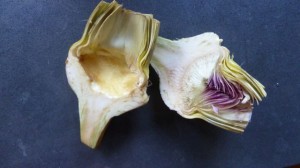


I can’t wait to try the recipe suggestions. I have always loved artichokes but never knew how to cut or prepare them.
Sounds delicious!